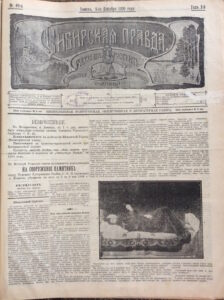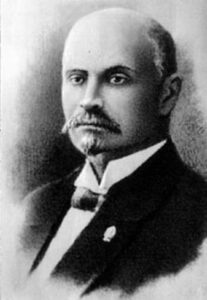My current research assistant found a blog post from 2012 that is, essentially, a scan of a pre-revolutionary publication about the murder of Ignatii Dvernitskii. Unfortunately, the blogger (a priest named Andrei Spiridonov) did not post the publication information for the book, and I’ve asked my research assistant to look into this.
In any case, the publication includes several photographs, including one from Ignatii’s funeral procession (below). It is also a defence of Ignatii, and includes a lot more information about the murder than did the newspaper reporting at the time.

Funeral Procession of Ignatii Dvernitskii. Original source unknown.
For instance, this publication states that yes, Ignatii was found strangled, but also that his neck was broken, and that his hand was clutched around his cross. The publication also defends his role at the school: admitting that Ignatii was very strict, the (still unknown) author states that Ignatii improved the food at the school and was generally a positive influence in what had been a hotbed of revolutionary activity.
If we can believe the basic details in this publication (and yes, I need to find out more about it), the author provides a description of how the Kuimov and Iurinov were caught. The author writes (forgive the rough translation),
The police chief found a fragment of a mother-of-pearl button from a shirt on the floor. Since all the buttons on the shirt of the deceased were intact, the police gathered all of the pupils and examined them. Gerasim Iurinov’s shirt had a broken button. When placed with the broken button found in the monk Ignatii’s room, it turned out that they fit together. […] The criminal first obfuscated, but then in prison not only confessed, but named his accomplice, Grigorii Kuinov [sic.]
Anyway, there is a lot more information to unpack in this piece, that I won’t bore you with, now. I’m skeptical, considering that the church went to great lengths to depict Ignatii as a martyr, that everything in this piece is true. Still, so far, it is the most detailed available account of the murder and the arrest itself.


